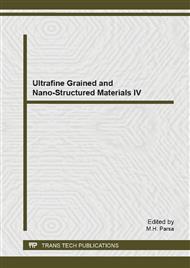p.337
p.342
p.347
p.352
p.357
p.362
p.366
p.371
p.376
Characterization of CIGS Thin Films Fabricated from Nanoparticles under Selenization Process
Abstract:
In the present report, the synthesis process of CuInxGa1-xSe2 nanoparticles as an absorption layer in tetraethylene glycol using metallic chloride and Se powder for the purpose of solar cell application. Whole processes were performed under glovebox condition. Nanoparticles sizes were achieved via manipulation of reaction temperature and various precursor concentrations. CuInxGa1-xSe2 or CIGS nanoparticles with diameters in the range of about 20-50 nm were prepared via polyol route and purified through centrifugation and precipitation processes. Then nanoparticles were dispersed to obtain stable inks that could be directly used for thin-film deposition via spin coating. Then, CIGS nanoparticles were coated on soda lime glass for fabrication of inorganic thin film solar cell via spin coating as a film. In those devices, the prepared films yielded relatively dense CuInGaSe2 films with some void spaces. For elimination of the void spaces, the nanocrystals were exposed to selenium vapor atmosphere. Filling the voids with selenium can lead to the fabrication of CIGS absorptive layers having good dense structures and high efficiency. CIGS thin films were characterized by various analytical tools, such as XRD, UV-Visible spectroscopy and SEM imaging.
Info:
Periodical:
Pages:
357-361
Citation:
Online since:
November 2013
Authors:
Keywords:
Price:
Сopyright:
© 2014 Trans Tech Publications Ltd. All Rights Reserved
Share:
Citation:


